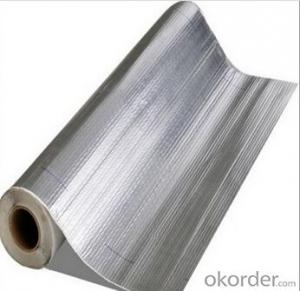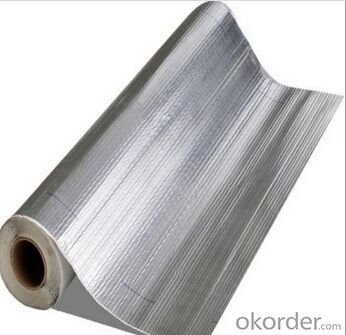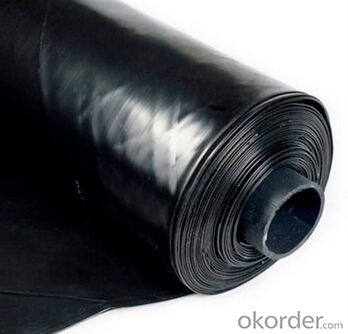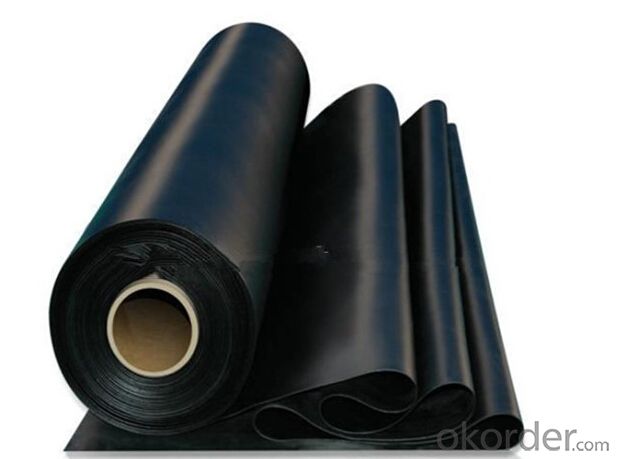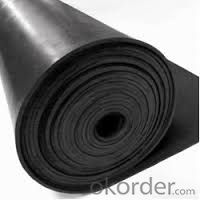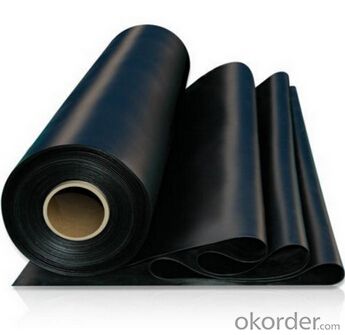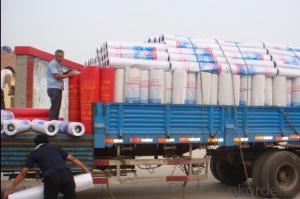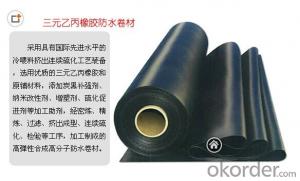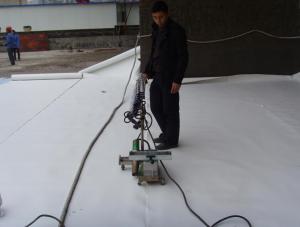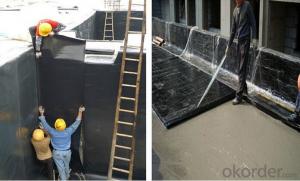Rubber APP Waterproof Membrane For Roofing In Wuhan By STAR
- Loading Port:
- Shanghai
- Payment Terms:
- TT OR LC
- Min Order Qty:
- 1000 m²
- Supply Capability:
- 100000 m²/month
OKorder Service Pledge
OKorder Financial Service
You Might Also Like
Product description
ROOF WATERPROOF SYSTEM-
EPDM MEMBRANE/COIL is made from ternary ethylene-propylene rubber. With the best performance among high polymer waterproof materials, EPDM is of exceptional elasticity and will not split or crack under normal building movement.
Application Scope
• Roofs, Basement, Toilet
•Industrial and civil building waterproofing
•Geo-synthetic liner for swimming pool, channels, irrigation system
•Especially suit for projects with high requirements in durability, anti-corrosion and deformation
Advantagee
•Excellent weather-ability, durability and size stability
•Good adaptability to high and low temperature, UV resistant and anti-corrosion
•High tensile strength and good elongation, accommodating to structure movement
•Easy installation, solid joint, and no environmental pollution
•Good rooting penetration resistance
•Service life up to 50 years
Storage:
Shelf life is 12 months. Store in a cool and dry place with
original packing.
5,Demension:
1.2mmx1.2mx20m;1.5mmx1.2mx20m;2.0mmx1.2mx20m
Advantages

Technical Parameters
1 | Breaking Tensile Strength(Room temperature) | Mpa | ≥7.5 | |
2 | Breaking Tensile Strength 60℃ | Mpa | ≥2.3 | |
3 | Breaking Elongation(Room temperature) | % | ≥450 | |
4 | Breaking Elongation(-20℃) | % | ≥200 | |
5 | Tearing strength | KN/m | ≥25 | |
6 | Impermeability, 30min no leakage | -- | 0.3Mpa no leakage | |
7 | Low temperature bending | ℃ | ≤ -40 | |
8 | Heating shrinking | Extension | mm | ≤2 |
Shrink | mm | ≤4 | ||
9 | Heat resistance (80℃x168h) | Tensile strength | % | ≥80 |
Elongation retentions | % | ≥70 | ||
10 | Alkaline resistance, Ca(OH)2 solution, room temperature x168h | Tensile strength | % | ≥80 |
Elongation retentions | % | ≥80 | ||
11 | Ozone aging(40℃x168h) | Elongation40%, 500x10-2 | -- | Non-crack |
12 | Synthetic aging | Tensile strength | % | ≥80 |
Elongation retentions | % | ≥70 | ||
Packaging & Shipping


Our service
1.sample: the sample is free ,you only should pay for the freight.
2.If you order to us ,we must promise the quality ,if some quality problem happened,
1)We will dispatch our Quality and Problems Appraisers to make a confirmation
2) Have a negotiation of the compensation and sign agreements
3) Our After-Sales Department will perform the duties as the agreements.
product show

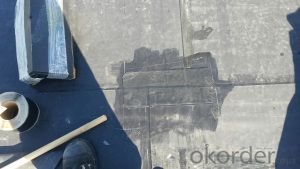
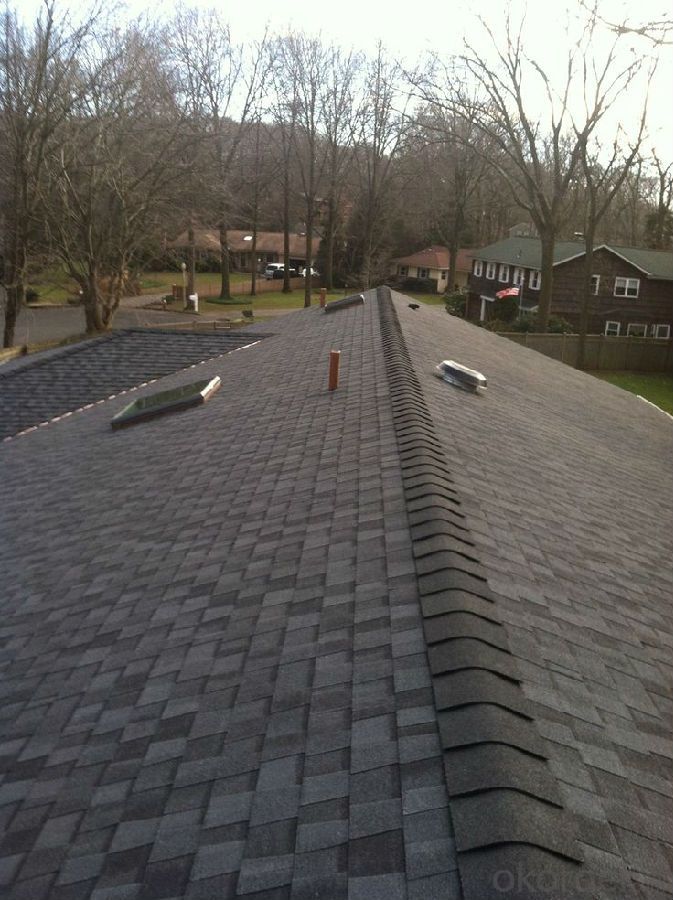
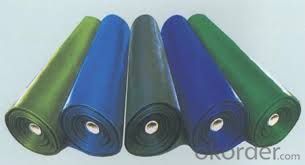
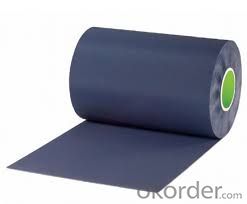
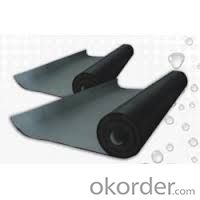
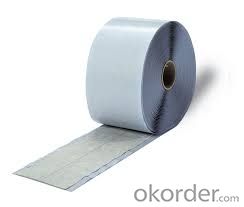
factory show
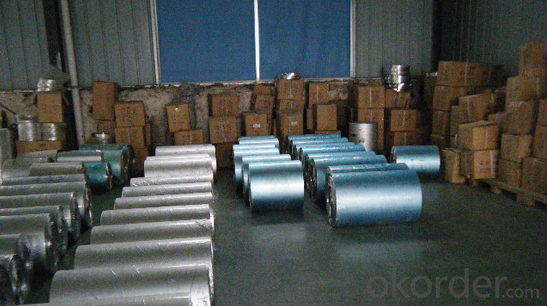

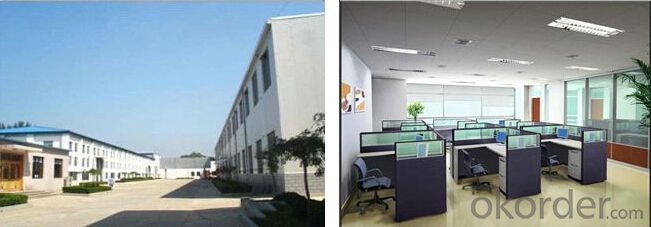
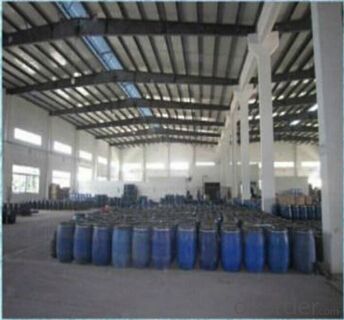
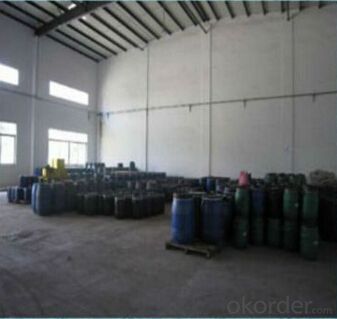
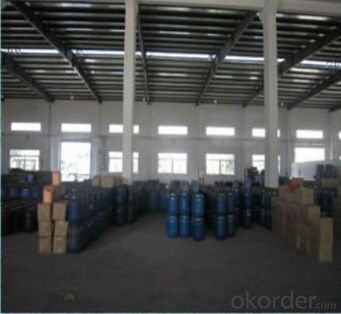
FAQ
Q: What's the de6abf1fe186f8d58506cbcfe46eed814d.jpglivery time ?
A: 3-5 days for 1-600 rolls, 10-15 days for container.
Q: What's the payment terms ?
A: TT/LC
Q: How do you make replacement with quality problems ?
A: New replacement will be packed into your next order or send to you directly after receive video or photo about quality problems.
- Q: Can a waterproofing membrane be applied on vertical surfaces?
- Indeed, vertical surfaces can be treated with a waterproofing membrane. It is common practice to utilize such membranes on exterior walls, retaining walls, and foundations in order to safeguard the underlying structure by averting water infiltration. These specialized membranes are formulated to adhere to vertical surfaces, serving as a moisture blockade. To guarantee optimal waterproofing performance, they are typically applied in multiple layers. Moreover, a wide range of waterproofing membranes are accessible, namely liquid-applied, sheet-applied, and spray-applied membranes, each of which can be customized to suit the specific vertical surfaces and construction needs.
- Q: How does a waterproofing membrane handle exposure to UV radiation?
- A waterproofing membrane is designed to handle exposure to UV radiation by incorporating UV stabilizers and additives in its composition. These components help to enhance the membrane's resistance to UV rays, preventing degradation and damage over time. Additionally, some waterproofing membranes have reflective properties that can further mitigate the effects of UV radiation. Overall, a well-designed waterproofing membrane can effectively withstand and protect against the harmful effects of UV exposure.
- Q: Can a waterproofing membrane be used on precast plastic surfaces?
- Yes, a waterproofing membrane can be used on precast plastic surfaces. These membranes are designed to be versatile and can be applied to a variety of materials, including plastic. They provide an effective barrier against water penetration and help protect the underlying surface from moisture damage.
- Q: Can a waterproofing membrane be used in combination with insulation materials?
- Indeed, the utilization of a waterproofing membrane alongside insulation materials is highly recommended. This combination offers heightened defense against water damage and moisture infiltration. The waterproofing membrane functions as a protective barrier, preventing water from infiltrating the building envelope, while the insulation materials regulate temperature and enhance energy efficiency. Merging these two components results in a sturdier and more efficient building envelope system. However, it is crucial to verify the compatibility of the selected waterproofing membrane with the insulation materials and adhere to proper installation techniques to guarantee a secure seal and optimal performance.
- Q: Does a waterproofing membrane require any special maintenance?
- Yes, a waterproofing membrane does require some special maintenance. While it is designed to be durable and withstand various weather conditions, regular maintenance is necessary to ensure its effectiveness and longevity. Some maintenance tasks include: 1. Regular inspections: Check the membrane for any signs of damage, such as cracks, tears, or punctures. Inspect the seams and edges to ensure they are properly sealed. 2. Clean the surface: Remove any debris, dirt, or vegetation that may have accumulated on the membrane. This can be done using a broom, brush, or pressure washer (if recommended by the manufacturer). 3. Clear drains and gutters: Ensure that the drains and gutters connected to the membrane are not clogged or blocked. This will prevent water from pooling on the surface and potentially causing damage. 4. Repair any damages: If any cracks, tears, or punctures are found, they should be repaired promptly to prevent water leakage. Follow the manufacturer's instructions for the appropriate repair method and materials. 5. Regularly check the waterproofing system: If the membrane is part of a larger waterproofing system, such as a basement or roof, it is important to inspect and maintain the entire system. This may involve checking the integrity of other components, such as drainage pipes or flashing. 6. Consider professional maintenance: Depending on the size and complexity of the waterproofing system, it may be beneficial to hire a professional maintenance service. They can conduct thorough inspections, perform necessary repairs, and provide expert advice on maintaining the membrane. By following these maintenance practices, you can ensure that your waterproofing membrane remains in good condition and effectively protects your structure from water damage.
- Q: Can a waterproofing membrane be used on vinyl surfaces?
- Indeed, one can employ a waterproofing membrane on vinyl surfaces. Vinyl surfaces, including vinyl flooring or vinyl siding, are frequently encountered in both residential and commercial structures. Waterproofing membranes are specifically crafted to establish a barrier against water and moisture, effectively hindering their infiltration into the underlying materials. By applying such membranes onto vinyl surfaces, an extra layer of safeguarding is provided, thereby guaranteeing that the vinyl remains unharmed by water-related issues or decay. Selecting a waterproofing membrane that is compatible with vinyl surfaces is crucial, as is adhering to the manufacturer's instructions for correct application.
- Q: Can waterproofing membranes be used on terraces?
- Terraces can definitely benefit from the use of waterproofing membranes. In fact, it is highly recommended to apply these membranes to protect the terrace's structural integrity and prevent any water damage. Waterproofing membranes act as a barrier, effectively stopping water from seeping into the terrace and causing undesirable leaks or cracks. They are commonly utilized on flat terraces, rooftop terraces, and even balconies to guarantee that water does not infiltrate the surface and cause harm to the underlying structure. Waterproofing membranes come in a variety of types, including liquid-applied, sheet, and self-adhesive membranes, offering diverse options that cater to the specific needs of the terrace. By applying a waterproofing membrane, the terrace can be safeguarded against moisture, UV rays, and other environmental factors, ultimately prolonging its lifespan and ensuring a resilient and long-lasting surface.
- Q: Are waterproofing membranes suitable for crawl spaces?
- Indeed, crawl spaces can be susceptible to moisture and water infiltration due to their positioning and inadequate ventilation. However, by implementing waterproofing membranes, one can effectively thwart water damage and issues arising from excessive moisture. These membranes are specifically engineered to establish a barricade against water and moisture, thereby preventing their intrusion into the crawl space and the subsequent development of problems like mold growth, decay, and structural deterioration. Moreover, the utilization of waterproofing membranes can contribute to enhancing the quality of indoor air by diminishing humidity levels in the crawl space. Consequently, it is strongly advised to employ waterproofing membranes in crawl spaces in order to guarantee a dry, sanitary, and healthful environment.
- Q: Can a waterproofing membrane be used on bridge decks?
- Yes, a waterproofing membrane can be used on bridge decks to protect the structure from water infiltration and extend its lifespan.
- Q: Does a waterproofing membrane require any specific preparation of the substrate before installation?
- Preparation of the substrate is essential for the installation of a waterproofing membrane. Before applying the membrane, the surface on which it will be placed must be thoroughly cleaned, dried, and devoid of any contaminants or debris that could impede its adhesion. This process typically entails the removal of loose materials, such as old paint or sealants, and the leveling of any uneven surfaces. Furthermore, it may be necessary to repair any cracks or damage in the substrate to guarantee a proper and efficient installation of the waterproofing membrane. By following the recommended preparatory procedures, one can ensure that the membrane performs optimally and exhibits remarkable durability, effectively safeguarding the underlying structure against water infiltration.
Send your message to us
Rubber APP Waterproof Membrane For Roofing In Wuhan By STAR
- Loading Port:
- Shanghai
- Payment Terms:
- TT OR LC
- Min Order Qty:
- 1000 m²
- Supply Capability:
- 100000 m²/month
OKorder Service Pledge
OKorder Financial Service
Similar products
Hot products
Hot Searches
Related keywords
